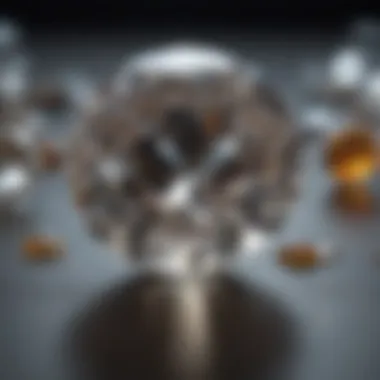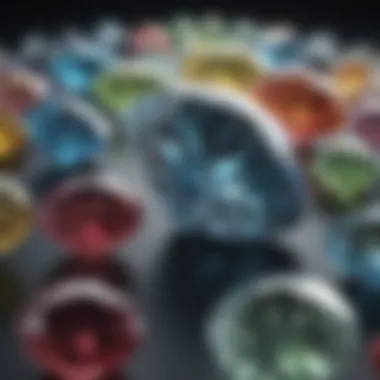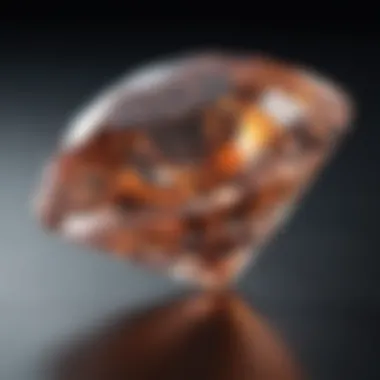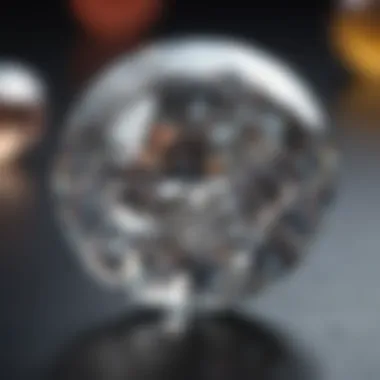Understanding Diamond Clarity and Color for Collectors


Intro
Evaluating diamond clarity and color is essential for any gemstone enthusiast or collector. Understanding how clarity and color affect the value and overall beauty of diamonds helps in making informed decisions whether buying or selling gemstones. This section introduces these core concepts, setting the stage for a deeper look into grading systems and the importance of specific characteristics.
Overview of Gemstones and Minerals
The world of gemstones is rich and diverse, encapsulating not just physical beauty but also a history intertwined with culture and society. From ancient civilizations to modern jewelry, gemstones have captured human fascination.
History of Gemstone and Mineral Use
Throughout history, gemstones have been symbols of status, power, and beauty. Early humans utilized local minerals in adornments or tools, deriving meaning and tradition from their use. Over time, cultures began to emphasize the distinct properties of various gemstones. For instance, Greek and Roman societies often associated sapphire with wisdom, while rubies were seen as symbols of love and passion.
Significance in Culture and Society
Many societies continue to attribute spiritual and physical healing to particular stones. Some cultures believe that wearing certain gemstones can provide protection or enhance one's life experiences. The historical context adds another layer to understanding diamonds and their clarity and color that serves to enrich today's appreciation beyond mere aesthetics.
Clarity and Color: Defining Characteristics of Diamonds
Those who appreciate diamonds recognize that clarity and color are not merely grading terms but elements that influence overall value, appearance, and uniqueness. Clarity relates to the presence of internal or surface imperfections, often called inclusions or blemishes, while color refers to the hue visible within the diamond.
Understanding diamond clarity and color provides a framework for both collectors and jewelry designers. Every minor detail counts in enhancing the brilliance of the stone.
In summary, evaluations of diamonds begin with the consideration of their foundational characteristics and how they tie into our historical and cultural perspective. As we explore these attributes, the nuances of this spectacular gemstone continue to unfold, demonstrating their essential role in both decor and sentimentality. Each diamond tells its own story through clarity and color, serving as a critical guide for those in pursuit of the perfect gem.
Understanding Diamond Clarity
Understanding diamond clarity is crucial for anyone interested in gemstones, whether for personal adornment or investment purposes. Clarity refers to the absence of internal or external flaws, which can impact the aesthetic value and overall desirability of the stone. A higher clarity rating usually equates to a more valuable and appealing diamond, while lower clarity can lower the price.
When evaluating diamonds, recognizing clarity ensures that collectors and enthusiasts can make informed selections. The significant aspects of clarity include recognizing different types of inclusions that might be present and understanding how these affect the visual appeal of the stone.
A comprehensive grasp of clarity helps individuals align their preferences with their budget, enhancing their buying experience. Buyers can also appreciate the uniqueness of each diamond, understanding how natural imperfections figure into each gem's character.
What is Clarity in Diamonds?
Clarity in diamonds describes the presence or absence of inclusions and blemishes. Inclusions are internal characteristics, while blemishes are external ones. These imperfections can take many forms and significantly influence the visual appeal of the diamond. A flawless diamond has neither inclusions nor blemishes visible under magnification, resulting in a shining stone.
While collectors often seek high clarity stones, many buyers also recognize charm in certain inclusions that add character to the diamond. A thorough understanding of gems allows enthusiasts to appreciate what makes each stone unique.


The Grading Scale for Clarity
The clarity of diamonds is evaluated on a standardized grading scale designed by the Gemological Institute of America (GIA). This scale categorizes stones from flawless to included, with several distinct categories in between. Understanding this scale is essential to selecting the right diamond - as each category emphasizes certain characteristics and values.
Flawless
A Flawless diamond has no internal or external characteristics visible under 10x magnification. This extreme level of purity contributes to its status as the crown jewel of gemstones, representing ideal beauty. Due to their rarity, such diamonds are highly prized and can fetch significant sums in higher-end markets. However, locating a truly flawless stone
Internally Flawless
Internally Flawless diamonds do show minor blemishes on their surfaces but are free from internal inclusions. This slight imperfection combines clarity and purity, making them very sought after. They are generally more accessible than their flawless counterparts but still hold considerable value, showcasing an almost perfect appearance.
Very Very Slightly Included
Very Very Slightly Included diamonds have minor inclusions that are difficult to detect without magnification. This category appeals to buyers seeking quality without the sticker shock of higher clarity grades. They can retain a beautiful sparkle and exceptional radiance, striking a balance between value and aesthetics.
Very Slightly Included
Very Slightly Included diamonds contain noticeable inclusions but are viewed as acceptable. These imperfections may become visible with careful viewing yet do not often detract from the overall beauty of the stone. Many buyers in this category find a solid value, facilitating a range of budget-friendly options.
Slightly Included
Slightly Included diamonds exhibit inclusions that are frequently visible without magnification. They offer affordability for those wishing to own a diamond without investing heavily. However, the inclusions may somewhat influence the light and decoration aspects of the stone. Buyers should be aware that
Exploring Diamond Color
Color is a fundamental element when assessing diamonds. It is one of the key factors that influence the stone's overall quality and market value. A deeper understanding of diamond color enriches the intuition for both buyers and sellers. In this section, we unravel the complexities of diamond color, its grading system, and how it affects pricing and jewelry setting choices.
Definition of Diamond Color
Diamond color refers to the hue that diamonds display when viewed in the light. The colors range from completely colorless to those with a rich presence of hues. It is essential to note that diamonds are better appreciated when they showcase a minimal amount of color, specifically in the form of yellow to brown tints. For informed selection, understanding how colors impact the quality of a diamond becomes critical.
The Color Grading System
Colorless
Colorless diamonds are at the top of the grading scale. They appear transparent and exhibit purity that many enthusiasts cherish. Their lack of color allows light to pass through and return brilliance to the observer. As a result, they are seen as a beneficial choice for engagement rings and other prominent jewelry pieces.
But, one must also acknowledge that they can be quite expensive given the demand for such only diamonds in market.


Near Colorless
Near colorless diamonds are only slightly tinted. The hue is often diluted to a point where it is almost undetectable. They allow a clean image and maintain high levels of brilliance without the high cost associated with colorless diamonds. For those who want a balanced blend between quality and affordability, near colorless is a great option. This makes it a popular choice, especially for those crafting bespoke pieces.
Faint
Faint diamonds display a light touch of yellow or brown which can slightly alter their brilliance. While they are more affordable, they may appear warm to the naked eye under certain lighting conditions. These traits can be satisfactory for those looking for an aesthetically pleasing but budget-friendly option. Knowing the limitations of faint diamonds is key to avoiding disappointment.
Light
Light diamonds present more apparent color but still can maintain vivid appearances. The light hues can sometimes add a bit of charm that pleases certain buyers. This category introduces consumers to a range of creative possibilities, especially in settings where accented colors are desired. However, the risk comes from the potential loss of value for formal investment pieces. Prospective buyers must weigh artistic preferences against value concerns.
Fancy Color Grades
Fancy color diamonds comprise those with noticeable hues, from blue to pink to green. Their artistic expression can capture the imagination of collectors and designers. Such diamonds rank higher in price not only due to rarity but also based on their unique visuals and characteristics. Their varying shades and patterns invite creativity in jewelry design but bring buyer's dilemma on market valuation since they do not follow the standard grading of clear diamonds.
Influence of Color on Price
The price of diamonds is significantly influenced by their color grading. Price varies along the scale from colorless to various grades influenced by how light interacts with the stone. Rarer colors like deep blue or pink command arguably the highest prices. Sellers and buyers must be aware of these factors for integretay in tranactions, ensures both interested parties are satisfied.
The Importance of Hue in Colored Diamonds
Colored diamonds have distinct hues, which add value, rarity and uniqueness. Certain huesahve their tread record higher in appreciation due to beauty perceived. Hence, Jules designers prefer stones like emerald for vogue designs due their aesthetics.
Evaluating the Ideal Color for Different Settings
The color of a diamond should also be evaluated based on its usage. A colorless or near-colorless diamond can work well in classic settings. Colored hues, such as light or fancy diamonds, could become focal points in detailed pieces where color coordination should not be neglected. Identifying how these factors interplay enhances the choice for the perfect diamond fitting.
The Balance Between Clarity and Color
Understanding the relationship between clarity and color in diamonds is critical for anyone interested in gemstone quality. Clarity refers to the internal and external imperfections present in a diamond, while color encompasses the hue or presence of any tint that detracts from its perceived quality. Both elements impact the overall beauty and monetary value of the stone. Therefore, knowing how these features interact is necessary for optimizing the selection process.
How Clarity and Color Complement Each Other
Clarity and color are interrelated facets in a diamond's evaluation. Exceptional clarity can elevate a diamond's appearance when complemented by a suitable color grade. For example, a diamond with high clarity appearing colorless will often surpass a stone with substantial hues even if it possesses comparable carat weight. The visual appeal requires these two aspects to harmonize. Clarity issues can be more noticeable in diamonds displaying significant color flaws. Conversely, and in various contexts, lighter hues can seem more enriching against diamonds that have minimal inclusions. Achieving a diamond where clarity and color collaborate positively is crucial in any selection.
Finding the Right Compromise
What constitutes the


Practical Tips for Selecting Clarity and Color
Selecting the right clarity and color for diamonds is a complex decision that requires careful consideration. This section provides essential tips to help you navigate through the vast choices available. Understanding the attributes that define a diamond's appeal is crucial for collectors, jewelry designers, and enthusiasts alike. Here, we will discuss practical steps you can take to ensure you choose a diamond that fits your needs and meets your expectations.
Assessing Your Personal Needs
Before making a diamond purchase, it is important to identify your own specific needs. Ask yourself what you value most in a diamond. Do you prioritize clarity or color? Different occasions or purposes may demand different characteristics. For instance, if you are choosing a diamond for an engagement ring, you may want a stone with the best possible clarity and color to signifying this important moment. On the other hand, unique jewelry pieces might benefit from more colorful choices or inclusions that add individual character.
Determine also the budget you intend to work within. Diamonds can vary dramatically in price based on their clarity and color. Identify which characteristics fit within your budget constraints. Consulting grading reports can assist in aligning your personal preferences with financial reality.
Consulting with Experts
When evaluating diamond clarity and color, expert guidance can be invaluable. Professionals familiar with the diamond industry possess knowledge that can help you make informed decisions. They can clarify nuances between grades and assist in striking the right balance between clarity and color. Try to find gemologists with good reputations and substantial work experience. They can provide advice not only on diamond selections but also on current market trends, which could influence long-term value.
Don't hesitate to ask specific questions about what inclusions might affect brilliance or how slight color tints will influence the overall look of the gem. By involving professionals, you gain from their expertise and potentially avoid costly mistakes.
Using Advanced Tools for Evaluation
With technological advancements, the tools available for evaluating diamond clarity and color have improved significantly. Each feature of a diamond can now be assessed more accurately through innovative equipment such as microscopes and other grading instruments. For instance, using loupe magnification or dZoom can help examine inclusions and UV fluorescence very precisely.
When possible, request a grading report from a reliable laboratory like the Gemological Institute of America or the European Gemological Laboratory. This documentation assures the diamond's attributes have been thoroughly tested. Digital imaging tools allow you to view diamonds online from the comfort of your own home. Here are some relevant points to keep in mind:
- Laser inscription: This identifies the diamond's certificate number. Ensure it matrces the grading report.
- Interactive 3D models: Enable analysis by rotating the image for a closer view of clarity and color.
- Color grading charts: Useful tools that allow you to see real examples of different grades can be helpful in the actual viewing process.
technology has revolutionized diamond evaluations, ensuring buyers make informed investments.
In summary, this article has navigated through fundamental aspects around clarity and color evaluation. Doing so can dramatically enhance your understanding, leading to a more satisfactory diamond selection. Putting these practical tips into action will ultimately empower you in your gemstone selection process.
Ending
Understanding diamond clarity and color is crucial for anyone seriously in the market for these gemstones. Both attributes not only add to the aesthetic appeal of a diamond but also greatly influence its overall valuation. Clarity defines the purity of the diamond, while color pertains to its hue, each contributing to the unique identity of a stone.
The comprehensive exploration of clarity and color lays the groundwork for informed decisions. Buyers need to weigh various factors, including personal preference and practical use, but knowledge enables them to make better choices.
Summary of Key Points
- Clarity Fundamentals: Grasp what clarity entails, focusing on the grading scales like Flawless and Included.
- Color Dimensions: Distinguish between different color grades, understanding how they affect diamond appearance.
- Value Interplay: Recognize the interplay between clarity and color to maximize value.
- Practical Tips: Assess personal needs and consult experts to avoid pitfalls.
- Future Developments: Stay informed about emerging evaluation techniques changing how diamonds are examined.
The Future of Diamond Evaluation
The future of diamond evaluation looks promising, with advances in technology offering more precise assessments of clarity and color. Methods like Artificial Intelligence will enhance grading accuracy. This expedited evaluation could lead to more standardized measurements. With clearer criteria, it simplifies searching for gems of value.
As gemstone enthusiasts and collectors become more discerning, their demands shape industry standards. Retailers and jewellers must adopt new practices and communicate transparently. Customers will place increasing value on certified diamonds, relying on extended knowledge for their purchasing decisions.
The landscape of diamond appraisal will keep evolving. Being well-informed is essential to make valuable investments as these shifts materialize.







